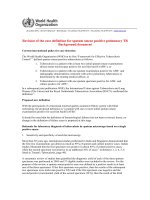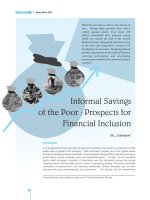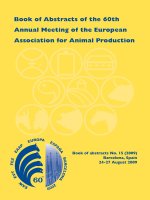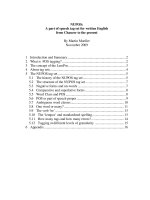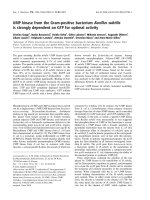OPTIMIZATION OF THE FERMENTATION MEDIUM FOR BACILLUS SUBTILIS STRAIN VTCCB51 TO ACHIEVE HIGH BIOMASS YIELD (LV tốt nghiệp)
Bạn đang xem bản rút gọn của tài liệu. Xem và tải ngay bản đầy đủ của tài liệu tại đây (677.07 KB, 34 trang )
goai
VIETNAM NATIONAL UNIVERSITY, HANOI
VNU UNIVERSITY OF SCIENCE
FACULTY OF BIOLOGY
Nguyen Thi Ngoc
OPTIMIZATION OF THE FERMENTATION
MEDIUM FOR BACILLUS SUBTILIS STRAIN
VTCC-B-51 TO ACHIEVE HIGH BIOMASS
YIELD
Submitted in partial fulfillment of the requirements for the degree of
Bachelor of Science in Microbiology
(International Standard Program)
Hanoi – 2017
VIETNAM NATIONAL UNIVERSITY, HANOI
VNU UNIVERSITY OF SCIENCE
FACULTY OF BIOLOGY
Nguyen Thi Ngoc
OPTIMIZATION OF THE FERMENTATION
MEDIUM FOR BACILLUS SUBTILIS STRAIN
VTCC-B-51 TO ACHIEVE HIGH BIOMASS
YIELD
Submitted in partial fulfillment of the requirements for the degree of
Bachelor of Science in Microbiology
(International Standard Program)
Supervisor : MSc. Hoang Van Thai
Dr. Pham The Hai
Hanoi - 2017
Acknowledgements
I would like to express my deepest appreciation to all those who have
provided me the possibility to complete this research.
First and foremost, I would like to express my sincere gratitude to my
advisors MSc. Hoang Van Thai who directed me, guided me to take the first
step in scientific research and he always made every effort in terms of
equipment and chemicals in time.
Furthermore, my sincere thanks also go to Dr. Pham The Hai who also
gave me orientations, always willing to answer all my questions about the
professional issues during my good thesis industry.
Besides, I am highly thankful to teachers, staff members and friends at
Department of of Biology, Siblings in the Department of Biochemistry and
Biochemistry Development, the teachers in the Institute of Microbiology Hanoi National University, VNU University of Science for their love and
kindness, insightful comments and suggestions.
Last but not least, I would like to thank my family for encouraging and
supporting me spiritually throughout my life.
Student
Nguyen Thi Ngoc
PREFACE
1. Reasons for choosing themes
Currently, in Vietnam as well as in the world, most people prefer
bioproducts. Bioproducts known for their use for controlling pathogens are a
growing boom in developing countries, where products are cultivated or
added to foods to enhance digestive balance. Of particular interest is that
biopreparations can be commercialized (Fuller, 1987). Therefore, among the
microorganisms used for biological preparation, Bacillus subtilis is a popular
example on the market today.
B. subtilis has many good qualities. They are food safety, have high
economic benefits (in Japan and in European countries). B. subtilis bacteria
stimulate immunity, prevent bacterial pathogens from entering the body, ...
Also they are functional foods to supplement beneficial bacteria. Thus, it can
be said that "B. subtilis is a strain of probiotics that is safe for users".
In addition, Vietnam is a very agricultural country with a great
emphasis on livestock and farming. In order to increase the productivity and
quality of products based on practical needs and promote their strengths, I
conduct research "Optimization of the fermentation medium for B. subtilis
strain VTCC-B-51 to achieve high biomass yield".
2. Objectives of the study
Study on the fermentation parameters of B. subtilis on a 10 liter
fermenter based on environmental factors and culture parameters (stirring
speed, air,...).
Abbreviation
B. subtilis
LB
T°
Sv
ODs
OD
h
Bacillus subtilis
Luria- Bertani
Temperature
Strain volume
OD strain
Optical density
Hour
List of tables
List of figures
Contents
CHAPTER 1: LITERATURE REVIEWS
1.1.
Overview for B. subtilis
1.1.1.
History of development
B. subtilis was first discovered in horse dung (1941) by the Nazi
German medical organization. At first, it was mainly used to prevent illness
for German soldiers fighting in North Africa[7].
Treatment had to wait until 1949-1957, when Henrry et al., obtaine the
pure culture of B. subtilis[16]. Since then, the term "subtilistherapie" has been
used to indicate the subtilis treatment of inflammatory bowel disease, colitis
and diarrhea due to digestive disorders.
Today, this bacterium is widely applied, thanks to the development of
biotechnology( as medicine, food and animal husbandry purposes).
1.1.2.
Classification
According to the classification of Bergey (1974), B. subtilis belongs to:
1.1.3.
- Kingdom: Bacteria
- Division: Firmicutes
- Class: Bacilli
- Order: Bacillales
- Family: Bacillaceae
- Genus: Bacillus
-Species: Bacillus subtils
Distribution
B. subtilis belongs to the intestinal microflora of the intestinal tract,
which is distributed almost exclusively in the wild such as hay, dust, soil....
Most of them exist in the soil, typically cropland soil containing about
10-100 million CFU / g. In poor nutient soil in deserts, wastelands, B. subtilis
is very rare. Water and mud at the estuaries as well as in seawater have the
existence of B. subtilis spores( Vu Thi Thu, 1996 )[7].
1.1.4.
Cell morphology
B. subtilis is bacterium with small size and short rod-shaped cells each
having two rounded tips of 0.5-1.0 μm x 1.5-3.0 μm; usually standing alone
8
or making short strings. The bacterium is a Gram-positive and has a capacity.
B. subtilis is bacterium of producing spores that can be and between the cell.
The bacterium is developed by the germination.
Figure 1: Cells of B. subtilis bacteria.
1.1.5.
Colony morphology
After 24 hours implanted on agar medium, B. subtilis usually produces
clear colonies that are: dry, milky white, crease on the surface of the agar,
creased and creamy lobes, in the middle with a knob small convex and often
referred to as concentric rings and clinging to the agar surface.
9
Figure 2: Colony of B. subtilis.
Figure 3: Colony of B. subtilis.
1.1.6.
The process of spore formation
Spores are a thickened solid biomass, the outermost of the spore is a
membrane. Crustaceans have many layers, which inhibit the penetration of
water and water soluble substances. Under the shell is the inner membrane of
the spore and in the same is a homogeneous mass of cytoplasm[1].
The outer membrane (Exosporium)
Sheathed (Tunique externe)
Covered in (Tunique interne)
Shell (Cortex)
Membrane biofilter spore center
Spore wall
Figure 4: Diagrams of internal structure bacterial spores (Nguyen Lan
Dung)[13].
10
B. subtilis spores are elliptical to spherical, measuring 0.6-0.9 μm x1.01.5μm, surrounded by multiple layers of lipoprotein, peptidoglycan,....
With the ability to create spores, bacteria can survive under adverse
conditions (depleted nutrients in the environment, the accumulation of
harmful metabolites and high temperatures, etc...)[7].
Each bacterium produces only one spore. When conditions are
favorable, spores will return to the vegetative cell.
Figure 5: B. subtilis spores are stained with malachite green.
The process of spore formation includes:
- Septum forming.
-Creating spore.
- Creating spore shell
- Synthetic spore shell.
- Releasing spores.
- When conditions are favorable, spores will germinate and develop into new
living cells (Nguyen Lan Dung et al., 2003).
11
Figure 6: The process of spore formation[1].
1.1.7. Spore composition
Spores contain large amounts of calcium, magnesium and dipicolinic
acid (this acid accounts for 5-12% of the dry weight of a spore). The role of
this acid is to make the spores resistant to high temperatures. Water content in
spores very low and exist in the form of link[2].
A spore of B. subtilis is oval-shaped when examined under an opaque
microscope, with its two ends are darker and can not be Gram-stained.
1.1.8.
Biochemical characteristics of B. subtilis
B. subtilis fermentation does not produce sugars: glucose, maltose,
saccharose, xylose, mannitol, etc...
Other biochemical characteristics of B. subtilis include: indol (-), nitrate
(-), VP (+), NH3 (+), H2s (-), aerobic (+), catalase (+), amylase (+), casein
(+), citrate (+).
Blood clots: Some strains cause haemorrhage in horses and rabbits due
to the action of hemolysin [8].
Table 1: Biochemical reactions of B. subtilis (Holt, 1992)
Biochemical reaction
Results
12
Catalase activity
Indol
MR (Methyl Red)
VP (Voges- Proskauer
Use citrate
Deodorizing Nitrate
Melt Gelatin
Mobile
Starch grading
Arabinose
Xylose
Saccharose
Mannitol
Glucose
Lactose
Maltose
+
+
+
+
+
+
+
+
+
+
+
+
+
+
1.2.
Research and application of B. subtilis bacteria in biological
products in the world
1.2.1.
In medicine
In the resistance war against France, B. subtilis preparations was
researched to fight the battlefield to resolve diarrhea.
In 1949, the oral medicinal product containing B. subtilis in the form of
IB 5832 was introduced in France. In 1955, oral medications were given in
powder form and capsules.
In 1962, Guy Albot discovered that B. subtilis is effective in treating
diarrhea due to antibiotic abuse and maxvital colitis, in combination with
other lactic acid bacteria that are effective in treating intestinal dysplasia.
1.2.2.
In agriculture
B. subtilis preparations are used to control pathogenic microorganisms
such as fungus Rhizoctonia solani, Fusarium sp, Pyriculariaoryaze and
postharvest products protection.
13
In 2013, the objective of this study was to evaluate the effect of dietary
supplementation of a probiotic bacterium, Bacillus subtilis, on the growth,
immune response and antioxidant activities of shrimp ((Litopenaeus
vannamei) by Wen-Ying Shen, Ling- Lin Fu, Wei- Fen Li and Yao- Rong
Zhu[9].
In 1940, Norio Kimura Yokohamo used B. subtilis to suppress the
growth and toxin production of Asperligus flavus, Aspergilus paraciticus.
Roman and colleagues studied B. subtilis (ATCC_6633, ATCC_9372)
which reduced 40-50% of aflatoxin in aflatoxin- fluid for 20 days[8].
1.3.
Research and application of B. subtilis bacteria in biological
products in Vietnam
1.3.1.
In medicine
B. subtilis has been studied for its properties, safety and viability and
development in the intestine (Hong et al., 2009).
In 1958-1960, Dr. Pham Ngoc Thach produced a series of B. subtilis
preparations for intestinal diseases.
The Department of Medical Hygiene of Bach Mai Hospital in Hanoi
has researched and produced B. subtilis for human diarrhea.
In 1971, Tran Minh Hung, Le Thi Ba, Nguyen Van Hung studied the
production of B. subtilis in the culture of soybean, crab ... steamed with
starch. This preparation is for pigs 0.5-1.0 g / kg body weight. Results of pigs
after using B. subtilis gained fast weight gain.
1.3.2.
In agriculture
The Biological Center of the Ministry of Agriculture in Ho Chi Minh
City has studied the production of Bactophyl from B. subtilis to control
fungus on vegetables.
Ho Thi My Hong, Nguyen Thanh Binh and the Hanoi Center for
Biological Production of B. subtilis to prevent disease in corn Ostrinia
furnacalis.
14
In 1982, Vu Van Ngu and his collaborators produced coliforms that
reduced recurrence due to diarrhea in pigs compared to antibiotic treatment,
resulting in rapid weight gain[8].
1.4.
Fermentation process
1.4.1.
Propagation
The purpose of propagation is to produce sufficiently high biomass for
inclusion in the production process. Propagation stage must be performed in
sterile cabinet to avoid infection. Then transferred to the heat shaking
machine for culture. Shaking speed is an important factor affecting the growth
of strains during propagation[1].
When the breeding process is finished, it is necessary to check the
strains to make sure the strains are not contaminated before production.
1.4.2.
Fermentation
This is the main stage of the fermentation process, so it is necessary to
closely control the conditions (eg: breeding rate, temperature, pH, air flow,
dissolved oxygen DO ...) the highest fermentation effect.
Sterility conditions during fermentation:
-Use the seeds not contaminated.
-Disinfect the environment and fermenter before use.
-Sterilize ingredients to be added to the fermenting pot during
fermentation.
-Maintain sterile conditions during fermentation.
During fermentation, cell growth should be monitored to adjust the
parameters accordingly to achieve high biomass yield. Tracking methods
include:
-Take a microscope stain on the microscope to evaluate spore quality.
-Measure pH and measure OD to build the calibration curve.
-The colony count on the agar plate contains the appropriate medium.
15
-Add the appropriate gas stirring time from time to time.
Note: During the fermentation process, the person wearing the mask
(should wear a blue shirt) and always have to sterilize his hands thoroughly
with 70 ° alcohol to avoid infection.
CHAPTER 2: MATERIALS AND METHODS
2.1.
Materials, chemicals and equipment
2.1.1.
Material
Microbial strain: B. subtilis strain VTCC-B-51 was provided by the
Vietnam Type Culture Collection of the IMB – Viet Nam National
University.
2.1.2.
Chemicals
Name of chemical
Yeast extract
Yeat extract
Peptone
KH2PO4
K2HPO4.3H2O
NaCl
Na2HPO4.2H2O
KCl
Agar
Gram dyes
Distilled water
2.1.3.
Brand
Merck
Merck
Merck
Merck
Merck
Merck
Merck
Merck
Vietnam
Equipment
16
Machinery and equipment available at the Institute of Microbiology
and Biotechnology include:
Name of equipment
37 ° incubator
Autoclave
Box implants
pipettes
Centrifuge
Shaking Machine
Fermentation system
pH meter
OD gauge
Optical microscope
And other common tools in the lab
2.1.4.
Brand
Germany
Japan
Eppendoft
Germany
Japan
France
Olympus
The fermentation system:
Manufacturer: Marubishi – Japan.
Product code: MDL.
Features:
+Accuracy, easy handing and flexibility.
+Six kinds of different size are avaiable (100, 200, 300, 500, 700 and
1000 ml) as standard.
+Accurate control.
+Highly effective aeration and stirring.
+MDL- 8 C controller realizes your highly sophisticated cultivation
work with max 8 channel.
17
Figure 7:
The
fermentation system in the laboratory.
18
Figure 8: Main form of fermentation batch cooker.
The main construction of the fermentation system includes:
- Air injection unit
- Stirrer
- Stirring shaft
- Partition
- PH electrode
- Oxygen electrode
- Thermal sensor
- Motor
Culture medium
The composition of the culture medium is presented in table 2.
19
Table 2: Composition of the culture medium (for 1 liter)
Material
Yeast extract
Meat extract
Pepton
NaCl
K2HPO4.3H2O
Distilled water
Mass(g)
5.0
2.0
5.0
1.0
1.9
1000ml
2.2.
Methods
2.2.1.
The physiological properties of B. subtilis
2.2.1.1. Determination of pH suitable for growth medium
The culture medium LB was distributed into triangular vases (60
ml/bottle) then H3PO4 (20%) and NaOH (0.5M) were used to adjust pH of the
medium to different levels:
Table 3: The pH of the culture medium tested for B. subtilis
pH requirements
4.0
pH after standard
3.99
20
pH after sterilization
4.01
4.5
5.0
5.5
6.0
6.5
7.0
7.5
8.0
4.48
5.01
5.51
5.98
6.49
7.02
7.52
8.01
4.50
5.02
5.52
6.01
6.49
7.01
7.51
8.00
Addition of 1 ml of B. subtilis culture medium (OD = 3.02) to the test
tubes, cultured for 46-48 hours in a thermostatic shaker with 37 ° C, shaking
150 rpm. During a 48-hour culture period of B. subtilis at different pH levels,
a growth test was performed by measuring the OD (by measuring the growth
ability of the spectrophotometer) every 6 hours from now 18 hours after
adding microorganism.
2.2.1.2. Determination of environmental temperature suitable for growth
Prepare LB medium and then put in 8 triangular vases with a volume of
60ml / bottle. For 1 ml B. subtilis strain (OD = 2.96), each of the 8 triangular
vases of B. subtilis was cultured within 48 hours at the corresponding
temperature levels of 20; 25; 30; 35; 37; 40; 45; 50°C.
During 48 hours of culture, B. subtilis at different temperatures was
tested for growth by measuring OD (Spectrophotometer) 12 hours from now
24hours after adding microorganism.
2.2.2.
Determination of the cell density changes
B. subtilis strain ATCC was cultured on LB medium. The culture was
incubated in a shaking incubator at 37 ° C and at 150 rpm for 36h in a 250ml
triangular vases containing 100ml of medium.
After 24h, B. subtilis was cultured to collect centrifugal cells, removed
fluid and add sterile saline to 1/10 of the original volume. Since the diluted
solution was diluted with salt, dilute 1/10,1/100,1/1000,1/10000, measured
OD and cultured count[3].
21
2.2.3.
Optimization of fermentation conditions on a 10 liter fermenter
Through investigation and empirical studies, identification of optimal
fermentation conditions for B. subtilis strains will be made in 25 fermentation
batches. Parameters and batch rates were set for each batch to produce
suitable parameters. The following parameters were experimented:
-Rating rate.
-Temperature.
-pH.
-The speed of the gas.
-Time of culture.
2.2.4.
Culturing steps
Strains
Propagation
Culturing on a 10 liter fermenter
Filtration/centrifugal translation
Step 1: Propagation
The strain was kepted under deep cooled conditions to be activated by
multiplying in a 250 ml triangular vases volume containing 150 ml-200 ml
LB culture medium, shaking at 150 rpm at 37 ° C for 18-24 hours .
After 18-24 hours, the sampling dye should been tested for the purity of
the variety at the same time to measure OD and pH to prepare for culture in a
10 liter fermenter.
Note: When propagation, stir the implant on an alcohol lamp flame;
limit communication to prevent .
22
Step 2: Culturing on a 10 liter fermenter
The LB medium was mixed into a 10 liter fermenter and checked the
air inlet, inlet, cap,...
Sterilizing the 10 liter fermenter with LB medium at 110 ° C / 30 min.
After sterilization, we were been cool down the 10 liter fermenter to
37°C.
The B. subtilis strain was multiplied from the triangular vases into the
10 liter fermenter, set the stirring mode, temperature and air flow depending
on the fermentation batch.
Sampling the OD and pH at the time of the test.
Samples was taken after 4-6 hours, stained for 6 hours after screening,
OD samples every 2 hours.
When B. subtilis was reached > = 80% of the spores, we were collected
biomass.
Step 3: Filtration/centrifugal translation
Concentrating solution by centrifugal method.
23
Figure 9: Filtration system concentrates B. subtilis biomass.
CHAPTER 3: RESULTS AND DISCUSSION
3.1.
Results
3.1.1.
Physiological properties of B. subtilis
3.1.1.1. pH suitable for the growth of the strain
During 48 hours of culture, B. subtilis with different pH was tested for
growth by measuring OD (spectrophotometer) 6 hours from the 18 hours
when adding the microorganism with the following table:
Table 4: Test results of B. subtilis culture in triangular flasks
at different pH environments
pH
0h
(OD
600nm)
18h
(OD
600nm)
24h
(OD
600nm)
30h
(OD
600nm)
24
36h
(OD
600nm)
42h
(OD
600nm)
48h
(OD
600nm)
pH
after
culture
4.0
4.5
5.0
5.5
6.0
6.5
7.0
7.5
8.0
0.14
0.20
0.17
0.12
0.16
0.18
0.19
0.22
0.18
0.13
0.15
0.14
1.74
2.35
2.39
2.09
2.11
1.40
0.17
0.14
0.04
1.79
2.48
2.74
2.23
2.38
1.91
0.05
0.12
0.13
1.86
2.62
2.82
2.44
2.54
2.38
0.08
0.12
0.16
1.95
2.92
3.14
2.91
2.99
2.43
0.22
0.15
0.24
2.18
3.10
3.18
3.01
3.04
2.56
0.27
0.13
0.57
2.24
3.12
3.21
3.05
3.08
2.87
4.03
4.53
5.02
6.96
7.26
7.66
7.46
7.74
7.63
Figure 10: Relationship between pH and growth capacity of
B. subtilis
According to the results( figure 10) of the culture of B. subtilis at
different pH environments, it was found that B. subtilis can grow at pH 5.5 to
8.0 and grows well at pHs from 6.0 to 7.5. This result was used for culturing
the strain in 10 liters fermenter.
3.1.1.2. Environmental temperature suitable for the growth of the strain
The B. subtilis strain was grown at different temperatures and OD (at
600 nm) was measured every 12 hours to establish.
Table 5: Test results for B. subtilis culture at different temperatures
levels
Temperature
0h
24h
36h
25
48h
pH after


